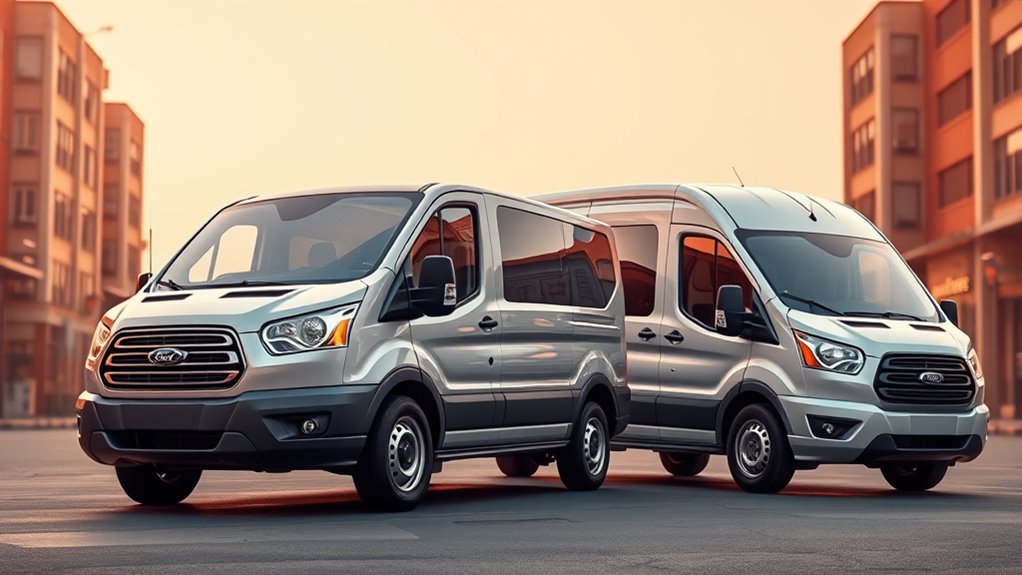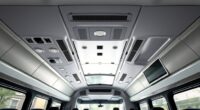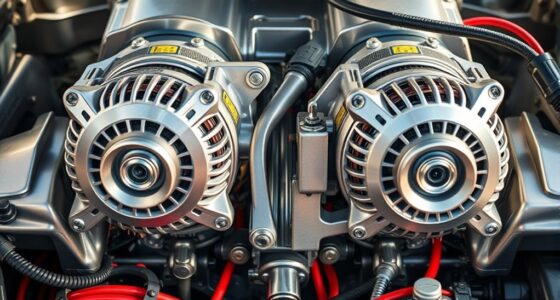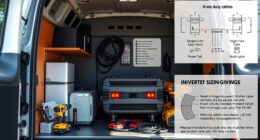The Ford Transit has evolved through four main generations since 1965, each bringing new designs, technology, and features. The first focused on durability and utility, while the second introduced sleeker lines and more body styles. The third added front-wheel drive and modern comforts, and the current fourth offers advanced safety, tech, and versatility. These updates reflect changing business needs, and exploring further reveals how this iconic van continues to innovate and adapt over decades.
Key Takeaways
- The Ford Transit has evolved through four main generations (1965–1985, 1986–1999, 2000–2006, 2013–present), each with distinct design and technology updates.
- The first-generation model introduced a forward-control layout, while later generations shifted toward more aerodynamic, versatile “one-box” designs.
- Engine options expanded from basic petrol and diesel to turbocharged, direct-injection, and hybrid systems, improving performance and fuel efficiency over time.
- New safety, comfort, and technological features, such as advanced driver assistance and ergonomic interiors, have been progressively integrated across generations.
- The Transit’s design and variants have adapted for diverse markets, including cargo, passenger, off-road, and specialized commercial versions.
The Birth of the Ford Transit: The 1st Generation (1965–1985)
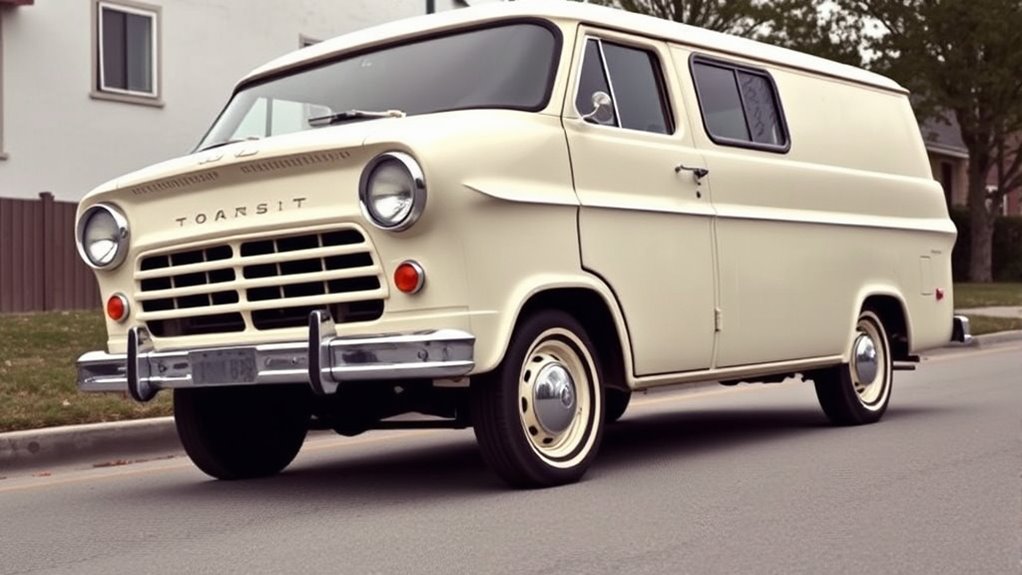
The first generation Ford Transit, launched in 1965, marked a turning point in commercial van design. You’ll notice it replaced the Ford Taunus Transit, adopting a forward control layout with a unibody chassis, which improved handling and interior space. Designed to balance passenger comfort and cargo capacity, it came in multiple body styles, including panel vans and chassis cabs. Engine options ranged from 42 hp in a 1.6L Diesel to 100 hp in a 3.0L gasoline engine, with manual transmissions and front-wheel drive. Its dimensions supported versatile cargo needs, with a wheelbase around 2690 mm and a length of about 4420 mm. Built for durability, the Transit’s robust suspension and body construction set new standards, making it a reliable workhorse across Europe for over two decades. Additionally, its versatile design allowed for numerous customizations to suit various commercial requirements.
Transforming Commercial Transport: The 2nd Generation (1986–1999)
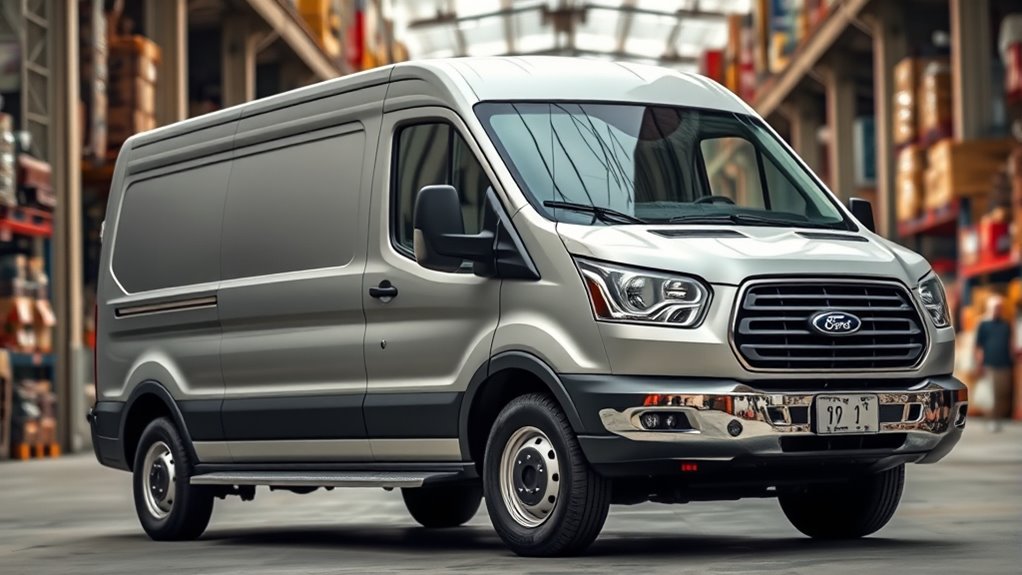
Introduced in January 1986, the second-generation Ford Transit revolutionized commercial transport with its sleek “one-box” bodyshell and versatile design. You could choose from six main body styles: Van, Kombi, Chassis Cab, Parcel Van, Bus, and Crewbus. Two wheelbase options—short (2690 mm) and long (3000 mm)—allowed tailored cargo and passenger capacity, while 32 door configurations enhanced accessibility. Under the hood, engine options ranged from 1.6L petrol to 2.4L diesel, with the 2.5L DI diesel from 1984 boosting fuel efficiency and performance. You mostly operated manual transmissions, with rear-wheel drive as standard. The chassis supported high customization, including different axle ratios and upfitted chassis cabs. Its adaptability made it a staple for various commercial applications across markets. The second-generation Transit also introduced improved safety features and an upgraded interior design, making it more comfortable and secure for drivers and passengers alike.
A New Era Begins: The 3rd Generation (2000–2006)

Spanning from 2000 to 2006, the third-generation Ford Transit marked a significant shift in commercial van design and technology. You gained more model options, including panel vans, chassis, camper vans, and crew vans, with doors ranging from 2 to 4. This generation introduced front-wheel drive alongside traditional RWD, broadening versatility. Engines included 2.0L turbodiesels with about 85-100 hp, and larger 2.4L engines for RWD models, with a notable 3.2L turbocharged five-cylinder arriving in 2006. The facelift in 2006 modernized the exterior and interior, added CAN bus electronics, and introduced the Sport Van trim with sporty styling. Its dimensions and capacities suited various commercial needs, making it a popular, versatile choice in its era.
| Feature | Details |
|---|---|
| Model Variants | Panel, chassis, camper, crew vans |
| Engine Options | 2.0L turbodiesel, 2.4L, 3.2L turbo |
| Drive Types | FWD and RWD |
Expanding Horizons: The 4th Generation (2013–Present)

The fourth-generation Ford Transit introduces advanced technology features that enhance safety and convenience, making it more adaptable for modern needs. It also marks the company’s effort to expand its presence in global markets by offering versatile configurations suited worldwide. As you explore this generation, you’ll notice how these improvements broaden the van’s capabilities and reach. Additionally, the design incorporates modern safety systems that help protect occupants and assist drivers in various conditions. Embracing space optimization can further improve the vehicle’s functionality and driver experience, especially in diverse operational environments. Furthermore, understanding the privacy policies related to vehicle data collection can help users make informed decisions about their information security. Incorporating organic materials in vehicle manufacturing is also gaining attention for its potential environmental benefits.
Enhanced Technology Features
Enhanced technology features in the 4th generation Ford Transit considerably elevate safety, comfort, and connectivity for drivers and passengers alike. You benefit from Ford’s Co-Pilot360 suite, which includes collision assist, lane-keeping, and departure warnings, boosting safety. Standard backup cameras help with parking maneuvers, while electronic stability and roll stability controls ensure vehicle stability. Inside, the cabin offers improved ergonomics, Bluetooth connectivity, climate control, and better NVH levels, reducing fatigue. The chassis features unibody construction for handling and ride quality, with suspension setups supporting urban and light off-road use. Additionally, color accuracy improvements contribute to a more engaging and visually appealing interior experience. These technological advancements are part of Ford’s commitment to cybersecurity measures that protect vehicle systems from digital threats. The following table summarizes key tech features:
| Safety Technology | Comfort Features | Connectivity Options |
|---|---|---|
| Collision Assist | Climate Control | Bluetooth Phone Control |
| Lane-Keeping Warnings | Improved NVH Levels | Auxiliary Power Sockets |
| Backup Camera | Modern Cabin Materials | Enhanced Interior Design |
Global Market Expansion
Since its launch in 2013, the 4th generation Ford Transit has substantially expanded its global footprint by establishing final assembly plants in key regions like Turkey. This move allows Ford to serve diverse markets efficiently, offering tailored configurations with multiple roof heights, wheelbases, and body styles such as cargo, passenger, and chassis cab variants. The Transit’s unibody design enhances versatility and reduces weight, adapting to regional needs. Engine options vary worldwide, including gasoline, diesel, and turbocharged V6s, with transmission upgrades like the 10-speed automatic improving efficiency. Market-specific features, payload capacities, and dimensions ensure the Transit meets local demands. Rear-wheel drive remains standard, while front-wheel-drive options support preferences across continents, cementing its position as a globally adaptable commercial vehicle. Understanding the vehicle’s design helps in appreciating its adaptability to various markets. Additionally, integrating renewable energy sources into manufacturing processes can further reduce the environmental impact of production.
Key Innovations Across the Lineup

Ford has consistently introduced key innovations across its Transit lineup to meet evolving customer needs and improve vehicle performance. In 2000, the fourth-generation Transit debuted front-wheel drive and modular platforms, offering greater drivetrain flexibility, improved handling, and simplified production. Load space utilization increased, especially with flat load floors in front-wheel-drive variants. The 2001 model introduced Durashift EST automated manual transmissions, enhancing driving ease and fuel efficiency, especially in urban settings. The launch of the Transit Jumbo series in 2001 and 2002 expanded payload capacities and cargo versatility, with low-floor models and multiple wheelbase options improving accessibility and operational efficiency. Additionally, safety and comfort advanced with features like independent front suspension, ergonomic interiors, and optional driver-assist features, ensuring the lineup remains adaptable and competitive across diverse commercial needs. Innovative design features have also played a significant role in maintaining the model’s relevance in the commercial vehicle market, with ongoing improvements driven by technological advancements that continue to shape the lineup. Furthermore, the integration of advanced chassis technology has contributed to enhanced durability and ride quality, reinforcing the Transit’s reputation as a reliable commercial vehicle.
Evolution of Engine Technology and Performance
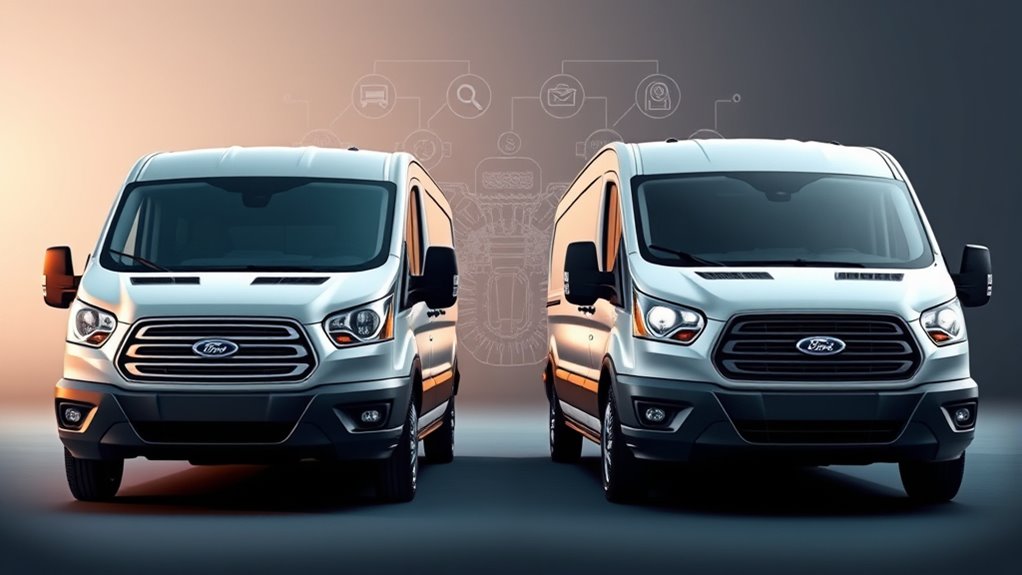
You can see how Ford has continuously improved engine technology to boost performance and efficiency. Over the years, innovations like turbocharging, direct fuel injection, and hybrid systems have enhanced powertrains while reducing fuel consumption. These advancements reflect Ford’s focus on delivering stronger, more economical engines for the Transit. Additionally, Ford has incorporated advanced emission control systems to meet stricter environmental standards worldwide. Moreover, ongoing research into alternative fuel sources has opened new possibilities for cleaner, more sustainable engine options in future models. As the automotive industry increasingly adopts automation technologies, Ford continues to innovate to stay ahead in both performance and efficiency. Furthermore, the development of preppy dog names and other breed-specific naming trends demonstrates Ford’s commitment to personalization and customer satisfaction in vehicle customization options.
Fuel Efficiency Advances
How have engine technologies evolved to improve fuel efficiency in the Ford Transit over the years? Early models used modest petrol and diesel engines, but in 1972, Ford introduced the York small high-speed diesel engine, which operated at higher speeds and lowered fuel consumption. Radial ply tires became standard in 1973, reducing rolling resistance and enhancing efficiency. Weight-saving measures like lighter springs further optimized fuel use. From the 1990s onward, TDCi turbo diesel engines and coated particulate filters improved fuel economy and emissions. In the mid-2000s, Ford integrated turbocharging, engine downsizing, and aerodynamics to cut fuel consumption. Additionally, the adoption of start-stop systems and advanced engine management technology has further contributed to fuel savings in recent models. Furthermore, innovations in engine design and material selection, such as lightweight alloys and composites, have helped reduce overall vehicle weight and improve efficiency. Moreover, engine calibration techniques have been refined to optimize combustion and reduce fuel wastage, reflecting continuous innovation in engine efficiency. More recently, hybrid systems and bi-fuel variants help drivers save fuel and reduce emissions, reflecting ongoing advancements in engine technology and performance.
Powertrain Innovations
Over the years, engine technology in the Ford Transit has seen significant advancements that boost performance and efficiency. You benefit from higher power outputs, better fuel economy, and reduced emissions thanks to innovations like turbocharging, direct injection, and Euro Stage V standards. Ford introduced diesel engines with improved driveability, sharing tech from passenger cars, and expanded gasoline options, including EcoBoost and larger V6s. Alternative fuels like CNG and propane became viable, increasing versatility. Recent updates integrated advanced transmission systems for smoother power delivery and better integration of engine control. These innovations ensure your Transit meets diverse needs—whether for heavy payloads, fuel savings, or eco-friendly operation—keeping it competitive across generations. Notably, engine management systems have become more sophisticated, optimizing performance and emissions.
Design and Comfort Enhancements Over the Years

Throughout its evolution, the Ford Transit has seen significant improvements in both design and comfort, reflecting changing customer needs and technological advances. Early models prioritized load capacity and durability, with minimal focus on driver comfort. The 1978 update introduced a streamlined bonnet and better engine access, along with a more powerful heater, marking a step toward enhanced usability. The second generation (1986–1994) added aerodynamics, independent front suspension, and optional features like air conditioning, boosting ride quality and convenience. The 2000–2006 third generation emphasized car-like ergonomics, better materials, and larger variants for increased space. Since 2013, the fourth generation has refined interiors with improved insulation, modern tech, and ergonomic controls, making long drives more comfortable and enjoyable. Improving repair efficiency and keeping up with technological advancements have also contributed to these enhancements, ensuring the vehicle remains competitive in the evolving automotive industry.
Notable Variants and Special Editions

The Ford Transit has produced several notable variants and special editions that showcase its versatility and performance. These models highlight unique design features, powerful engines, and custom capabilities. You might find rare limited editions like the Transit Hallmark from 1995, with only 600 units, or the high-end Transit XXL stretch limousine from 2007, celebrating its award. The performance-focused SuperSportVan features a turbocharged 3.2L engine, while the Mk2 Supervan models boast race-inspired engines like the Cosworth DFL and GT40. Off-road enthusiasts can explore the Transit Trail, equipped with AWD and a twin-turbo V6. Additionally, various camper and minibus configurations demonstrate the Transit’s adaptability across diverse uses. Special editions also often include unique styling and features that make them highly collectible among enthusiasts. Exploring model variety reveals the extensive range of configurations designed to meet different customer needs, and understanding vehicle customization options can help owners tailor their vans for specific purposes.
The Global Impact and Legacy of the Ford Transit
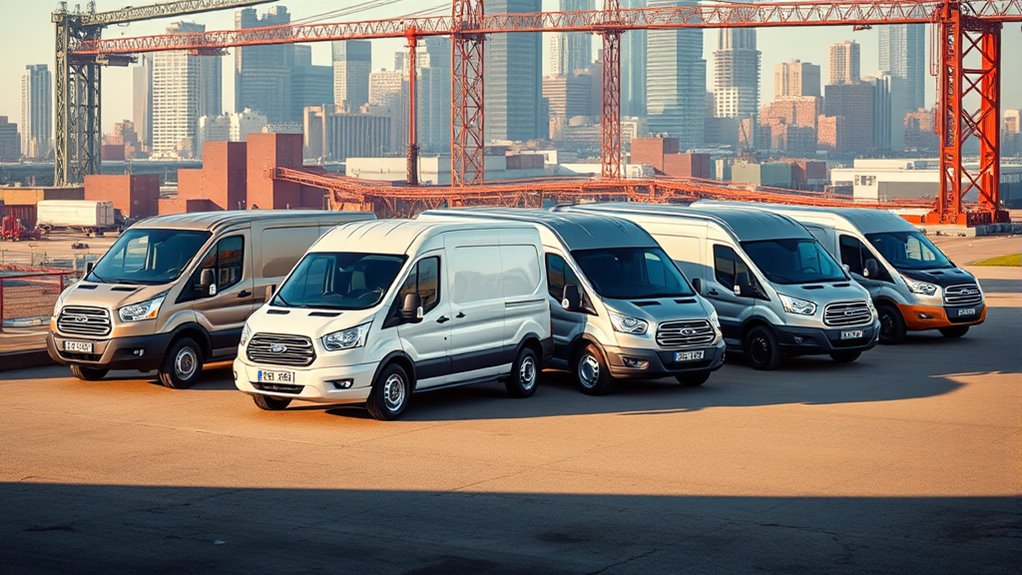
Since its debut, the Ford Transit has established itself as a global icon in commercial transportation, shaping markets and influencing business culture worldwide. Its sales soared, with around 400,000 units sold in 2015, making it the best-selling cargo van globally. In Europe, Ford became the top brand, increasing market share from 10.7% to nearly 13%. In the U.S., it captured about 40% of the full-size van market by late 2016, marking Ford’s strongest sales since 1978. Its expansion continues in Mexico, China, and the UK, with forecasts predicting at least 10% growth. Early Chinese production in 1997 and joint ventures with Jiangling helped solidify its Asian presence.
| Region | Impact | Key Achievement |
|---|---|---|
| Europe | Market dominance, cultural icon | 17-23% sales growth in 2016 |
| North America | Market leader, fleet favorite | 164,000+ units forecasted in 2024 |
| China | Early entry, local manufacturing | 67,326 units sold in 2016 |
| Global | Industry influence, sales growth | 400,000 units sold in 2015 |
Frequently Asked Questions
How Has the Ford Transit’s Safety Technology Evolved Over Its Generations?
You’ll see that the Ford Transit’s safety tech has come a long way. Starting with basic structural safety, it moved to airbags, airbags, and mechanical upgrades. More recently, it features advanced driver-assist systems like Pre-Collision Assist, lane-keeping, and adaptive cruise control. In 2020, all-wheel drive and expanded Co-Pilot 360 make driving safer and easier in various conditions, actively helping you avoid accidents and stay in control.
What Are the Main Differences Between the Transit Models in Different Regions?
You’ll notice regional differences in Transit models, like engine choices, body styles, and features. North America favors larger, high-roof cargo vans with a twin-turbo V6 and safety tech, while Europe gets smaller, versatile models with diesel engines and options like front-wheel drive. Production in various countries allows for adaptations to local regulations, demands, and preferences, resulting in diverse configurations and trims tailored to each market’s needs.
How Has the Cargo Capacity Changed Across the Transit’s Four Main Generations?
You see, your trusty Transit has grown from a humble box to a cargo beast. Starting around 2,200 lbs in the first generation, it now boasts up to 4,500 lbs in the latest model. Thanks to better design, materials, and engineering, each generation has cranked up the payload, making your van more capable, versatile, and ready to haul whatever chaos you throw at it.
What Are the Key Factors Driving Ford Transit’s Global Popularity?
You’ll find that Ford Transit’s global popularity is driven by its versatile powertrain options, including hybrid and electric models, catering to eco-conscious buyers. Its wide range of configurations suits various industries, from cargo to passenger transport. Additionally, its strong legacy of reliability, durable design, and extensive service networks make it a trusted choice worldwide. These factors, combined with continuous innovation and local manufacturing, keep the Transit a top contender in the commercial vehicle market.
How Do the Various Engine Options Impact Fuel Efficiency and Maintenance Costs?
Your choice of engine impacts both fuel efficiency and maintenance costs considerably. Diesel engines like the 2.2L and 2.4L Duratorq boost fuel economy and durability but may require costly repairs. Gasoline engines, such as the EcoBoost V6, offer more power but consume more fuel and might need more frequent servicing. Upgrading to newer transmissions and alternative fuels can reduce expenses, helping you balance performance, economy, and maintenance.
Conclusion
As you’ve seen, the Ford Transit keeps evolving with each generation, pushing boundaries and redefining what a commercial van can do. But what’s next for this legendary lineup? With new innovations on the horizon, you can’t help but wonder—will the future hold even more surprises? Stay tuned, because the story of the Ford Transit is far from over, and the next chapter promises to be nothing short of groundbreaking.
